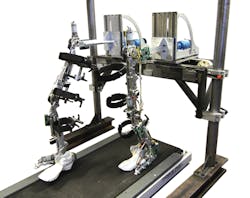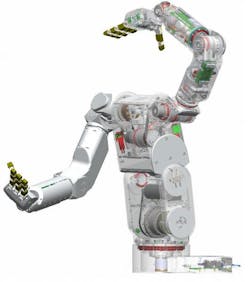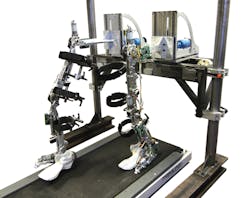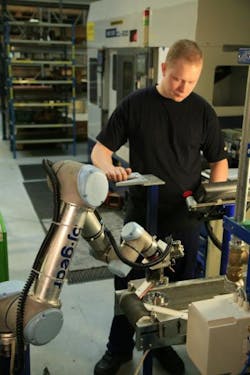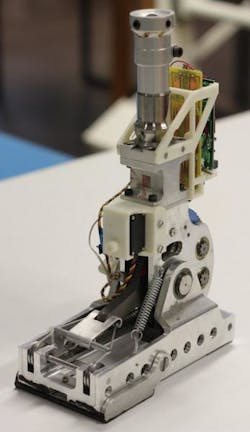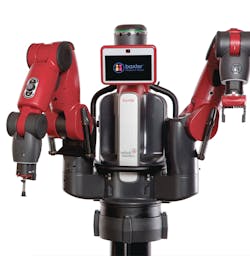The rise of soft robots and the actuators that drive them
Inexpensive robots of all forms are on the rise.
Most are tailored to specific applications, so they don’t rely on programming for all their intelligence. Instead, their geometry and actuators themselves carry some smarts. Many use cost-effective parts and compliant actuators. These soft robots yield and shift from their equilibrium position when subject to a disturbance force. They range from basic DIY stretch-cable-and-link hands on instructables.com to Dept. of Defense UGVs with all the sophistication of traditional industrial robotics.
This file type includes high-resolution graphics and schematics.
Why compliant actuators?
Traditional robots are built for industrial automation. They have precision linkages controlled by PID loops with large gains that quickly correct for disturbances. Gearmotor-driven actuators usually move the linkages while encoders track joint positions and allow position control. Actuator dynamics (including masses, reflected inertias, and stiffnesses) heavily influence the system’s controls and overall performance. They impart high (ideally infinite) mechanical impedance, meaning the robots resist motion when subject to a force. The robots also have high bandwidth and quickly move to commanded positions no matter what external forces act on their joints. That’s perfect for industrial automation because it lets robots track trajectories in static or mapped environments — in pick-and-place applications, for example.
But these features aren’t good for robots that interact with unmapped and dynamic environments. New types of robots must act as coworkers that help humans — check out the photo gallery at this link — and assemble devices on manufacturing lines, for example. Others strap onto human limbs to make soldiers stronger or paraplegics mobile. Still others navigate households or outdoor environments and must move themselves efficiently.
Four promises of soft robotsBram Vanderborght, Robotics & Multibody Mechanics Research Group (R&MM), Vrije Universiteit, Brussels |
|---|
|
1. Soft robots move swiftly and accurately but never harm humans or themselves. 2. Soft robots are efficient — particularly those that walk. 3. Soft robots recover from external perturbations and unpredictable model errors — a.k.a. changes in the environment. For example, the COmpliant huMANoid robot Coman, developed at the Italian Institute of Technology, Genova, has 25 compliant actuators and torque sensors to walk with a natural gait and stay upright even when shoved. 4. Soft robots adapt to apply just the right force in interactions with people and applications that require continuous contact — in hands-on assistive devices, exoskeletons, and haptics. |
All the parameters in such applications aren’t measurable, so position control becomes difficult. What’s more, traditional robots’ stiff actuators can’t store and release energy or exploit natural dynamics, making them too inefficient for mobile designs. Finally, the high reflected inertia of gearmotors in industrial robots can hurt people during collisions.
Soft robots address these issues. They also do better in uncontrolled environments, according to soft-robot researcher Bram Vanderborght of the Robotics & Multibody Mechanics Research Group (R&MM), Vrije Universiteit, Brussels. They’re not suitable for applications requiring nanometer or micrometer precision: “Many soft robotics compromise performance and payload for safety,” says Nick Hunt, manager of technology and support, ABB Robotics North America, Auburn Hills, Mich. However, some soft robots are starting to overcome the challenges of low controllability (low bandwidth), complexity, and cost.
Evolution of compliant robotics
In the 1980s, MIT researcher Neville Hogan first outlined the basics of impedance control and the idea of getting compliant behavior from motors with software. Then came compliant hardware elements. The first were air-spring-powered hopping robots and series elastic actuators (SEAs) developed at the MIT Leg Lab by Gill Pratt and Matt Williamson. An SEA is a traditional motor-powered actuator fitted with a spring that attaches to the load. In the last decade, other compliant actuator types have been developed and used, including some based on shape-memory alloys, magnetostrictive materials, and pneumatics. For example, a bionic elephant trunk released in 2010 by Festo, Esslingen, Germany, is stuffed with polyamide bellows that bend the trunk’s gripper in different directions depending on how they’re inflated. The compressibility of the air in the bellows makes the arm yield to external forces, so it’s gentle enough to handle delicate objects.
Some traditional robots built for high-end industrial applications use software to impart virtual compliance, often called active compliance. For example, arms from ABB Robotics use SoftMove, active-compliance control software that measures external forces and then reduces joints’ output forces as needed — letting the robot float and comply with external forces. Ultimately, that helps robotic arms “tend” to other machines in a plant more efficiently — for example, in automotive assembly, to hold and press a part into a car body while another process attaches the part to the body.
In contrast, robots like Festo’s elephant trunk and Baxter (from Rethink Robotics, Boston) use passive compliance by leveraging mechanical elasticity. On Baxter, SEAs on all seven axes incorporate actual springs to help the 165-lb robot execute mundane tasks too simple to justify full industrial robotics.
SEA components and controls
SEAs are one of the most basic compliant actuators and are currently the most commercialized. Like other compliant robot actuators, they reflect less inertia back to motors and decouple motor inertias from the robotic limb should the robot accidentally hit something. “That means when an SEA-driven robot smacks into something, it just bumps off without causing harm — and that’s an inexpensive way to build safety into the design,” says Aaron Edsinger, Ph.D. and cofounder of Meka Robotics, San Francisco, another manufacturer that uses SEAs in nearly every joint of their robots.
SEAs also isolate gearboxes from shock and reduce the effects of a gearbox’s backlash and friction on output, which lets robot makers use low-cost gears. Plus, when the aim is only millimeter-level precision, SEAs work well with unexotic motors and midgrade bearings.
Finally, SEAs bring down robot costs by measuring electrical current in the joints to determine force and movement rather than rely on expensive sensors (like robots that operate under position control). The SEAs change a robot joint’s equilibrium position via actuator stiffness. A sensor tracks spring deflections and uses those values to calculate force on each joint according to Hooke’s law — F = k . (x – x0), where F = generated force; k = stiffness; x = actual spring length; and x0 = rest length. The controller sums each force and the total resultant force profile then becomes the basis for motion adjustments. Feedback is derived from motor-winding currents and spring deflections (position). In other words, a simple PID loop around the spring deflection controls torque, so the controller calculates forces and then changes the spring’s setpoint (x0).
“In ours, the motors are controlled closing a current-control loop on the amplifier DSP and then closing a torque loop around the spring deflection that commands a current to the inner loop, all on a DSP at 2 kHz,” Edsinger says.
One caveat: SEAs have low zero-motion force bandwidth and so have trouble holding precise positions. Software such as the Robot Operating System (ROS) must predict lost motion to compensate. Some robot makers leverage this trait by adding gravity compensation so users can push and pull the robot arms around for follow-my-lead programming.
SEA-driven robots can also use sensorless technology to detect collision forces and stop the robot, according to Edward Mullen of Universal Robots USA, Wading River, N.â Y. “On our UR5 and UR10 arms, each joint monitors motor current and joint position from dual encoders. The controllers use this data to derive the force exerted for each joint, which streams back to redundant microprocessors that determine if it falls within normal conditions.” Universal’s robotic arms handle microscopically small parts with repeatability of 0.004 in.
As with any actuator, SEAs present design limitations, trading the benefits of compliance for some performance. To address SEAs’ performance limitations and to output higher-bandwidth force, newer variable impedance actuators (VIAs) use power inputs in tandem to let controls separately adjust stiffness. In iterations that use antagonistic stiffness control, two compliant actuators are mounted in the machine to oppose one another, much like a bicep and tricep in a human arm. That lets the arm move up, down, and (if both actuators are powered) stiffen. Two examples are variable-stiffness actuators (VSAs) and quadratic designs that split twin spring-linked SEAs with a wedge attached to the load.
Another VIA approach is to mechanically control stiffness, as in the VS Joint developed by the German Aerospace Center and the MACCEPA developed by R&MM researchers. These actively make joints stiffer or more compliant on the fly: One motor controls torque while another controls spring stiffness (and equilibrium position). This lets MACCEPA outperform other compliant actuators and is why it’s used in fish robots, arms to throw balls, and exoskeleton robots. It’s difficult to compare MACCEPA’s overall cost to that of alternatives because most aren’t commercial products yet. However, Vanderborght thinks the actuator could prove cheapest, as it’s easy to make with just a few off-the-shelf components. Controls are customizable to how compliance is used in the application — for stabilization or energy storage, for example.
“VIAs make designs that adapt, and not just with control and computation,” says Vanderborght. “The idea is that the dynamic interaction between a robot’s morphology, sensory-motor control, and environment should dictate its form, because natural movements have better safety, energy efficiency, and dynamics.”
Others agree that motor-powered compliant actuators such as SEAs and VIAs excel in soft robotics. “For example, some believe electric actuators aren’t suitable for rehabilitation robots that must not force limbs along preprogrammed trajectories,” says Kenneth J. Hunt, Bern University of Applied Sciences, Switzerland. That’s because in traditional control engineering, dc motors are driven to deliver setpoint tracking. This has spurred morphological actuators with obvious compliance, such as artificial muscles in orthotics that inflate to get mechanical leverage.
Hunt argues that even rehabilitation robotics can use dc motors that employ impedancelike control strategies. “Motor drives and controls are mature technologies and a solid choice for getting soft behaviors from robots,” he says. For example, the compliant-actuator-powered Lokomat exoskeleton made by Hocoma Inc., Norwell, Mass., straps on patients and pairs with a treadmill and motion-simulation screen to safely help stroke victims retrain their brains’ muscle controls.
Other compliant robotics
That’s not to say that motors are the only solution for soft robots. Artificial muscles powered by pneumatics abound, and an array of compliant-robot innovations is on the horizon.
Consider electroactive polymer artificial muscles (EPAMs) made by Artificial Muscle Inc. of Sunnyvale, Calif., in which electrodes sandwiching polymer films force them to contract when voltage is applied to, in turn, move attached loads.
And some new soft robots are weirder still. Researchers at Cornell University’s Creative Machines Lab, Ithaca, N.â Y., are designing robots built of stacked cubes stuck together. Stiff cubes give leverage while pliable ones expand and contract to drag, waddle, or heave the robot along. A prototype with open-cell foam cubes actuated by environmental pressure variation confirms the design works, and researchers hope future versions will be manufactured additively.
But soft-grasping robots may show the most innovation in coming years. Unlike common industrial grippers that rely on rigid linkages and accurate models of the environment, compliant grippers directly interact with objects. For example, robotic tentacles from the OCTOPUS Project led by Scuola Superiore Sant’Anna researchers, Italy, have arrays of shape-memory-alloy cables attached to a center steel cord that tighten and release to curl, extend, retract, or straighten the tentacle. A silicone skin studded with contact sensors and passive suckers let the tentacle grasp objects.
Final note: Standards dictate safe interactions
Many soft robots are specifically designed for CoBoting — helping people assemble devices, sort items on a line, lift parts, and more. Dictating what’s considered safe interaction is the Robotic Industries Association R15.06 standard and the ISO standard for collaborative robots. “In a collision, our robot delivers less force than the 150-N (33.72 lb) regulatory limit [EN ISO 13850]. So, depending on the application, Universal Robots may be able to operate without an enclosure,” says Mullen of Universal Robots.
A risk assessment should be done for any industrial motion control applications, as end effectors and other conditions can create hazards. “But in the 1,600 applications our robots are currently automating, 80% don’t require enclosures,” Mullen adds.
Soft robots aren’t the only answer for safe human-robot operations. Nick Hunt of ABB underscores that some traditional robots meet these safety parameters and don’t need to be caged. He says computational electronics and sensing devices, both tactile and optical, and the associated cost of implementation, will dictate future CoBoting innovations. “Our approach now is to keep momentum low, keep servo compensation as responsive as possible, and allow compression at the point of contact.”
Download this article in .PDF format
This file type includes high-resolution graphics and schematics.
• Machine Design’s first article on Rethink Robotics and Baxter
About the Author
Elisabeth Eitel
Elisabeth Eitel was a Senior Editor at Machine Design magazine until 2014. She has a B.S. in Mechanical Engineering from Fenn College at Cleveland State University.
